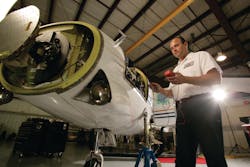It has not been all that many years ago where many considered electrical systems in aircraft more of a convenience than a necessity. After all, information required to fly could be obtained without the use of wires and electron flow. Instruments used to display speed and altitude were powered by actual air pressure changes and gyroscopic indicators were driven by a regulated air flow. Aircraft direction was determined based on orientation to the earth’s magnetic field via a compass and even take off and landing ques could be obtained through light signal.
Back then passenger amusement was derived by looking out the window at the shrinking sights below as the aircraft climbed ever higher into the atmosphere. In fact, considering all the transcripts and articles I have perused over the years concerning the Wright Brothers, I don’t recall any reference to cabin entertainment systems, communicating with satellites, or even use of digital data.
Reverberations of newer technology are being felt throughout our industry with many of our constituency being forced into the roles of computer network engineers, developers, and technicians. Flight crews not familiar with the ins and outs of microprocessors don’t realize the dilemmas encountered when actions are attempted prior to completion of a system boot up cycle and many a maintenance technician has been lead down an erroneous path while trying to interpret digital diagnostic systems.
Our maintenance repair organizations (MRO), being on the front lines, frequently take the brunt of the frustration as they often handle older aircraft which are being retrofitted with new generation systems. Often equipment manufacturers are more in tune with having their systems installed in bulk by airframe manufacturers on new aircraft and are not all that interested in supporting the one-off installation in an older machine. Certification these days is often more involved than in years past particularly if the planned equipment has not previously found its way into a specific type or like kind aircraft.
More of a necessity
Aircraft electrical systems have evolved into a necessity and even more so today with the advent of “fly by wire” flight controls, power by wire throttles, and even electronically controlled wheel braking. In the case of transport or business aircraft that now have the ability to circumnavigate the globe with as few as three stops, keeping the passengers amused and occupied now requires more than a newspaper and in-flight movie.
Many of the trends driving home or office electronics have been working their way into aviation with part of the dilemma being the end users do not always understand limitations may be associated with certain equipment being operated at 45,000 feet while traveling 85 percent the speed of sound. In other words, surfing the net may be a different experience in an aircraft than sitting in the local internet café.
Today's electronics
Technology is associated with advancement and implementation of electronics in aircraft which does provide significant benefits including weight savings along with equipment made up of few moving parts theoretically reducing maintenance costs and improving longevity. Incorporating new technology does, on occasion, provide challenges.
Transport category aircraft certified in the United States are intended to be designed and manufactured in compliance with Federal Air Regulation (FAR) Part 25 and with the onset of the digital age, an addition to certification criteria was needed. Subpart H was created late in 2007 and is titled “Electrical Wiring Interconnection Systems” or just EWIS. Information covers electronic equipment installation, routing of wires, termination, connectors, and even shielding.
Awareness of EWIS criteria is essential to the success of any new digital electronic equipment installation. In some cases equipment installers are not given the knowledge to fully understand that running a length of CAT 5 cable is not accomplished the same way as installing a similar diameter feeder cable. Network digital buses consist of several independent conductors that are strategically shielded and insulated which makes them for the most part, impedance critical. Impedance is an electrical property associated with resistance, inductance, and capacitance; all of which must be in harmony to allow proper data flow.
The dilemma here, if a wire clamp or even a tie wrap is overtightened, the capacitance factor of the cable may be altered and the end result may be less than desirable. There have been situations where impedance critical cables pass through pressure bungs as they enter or exit pressurized compartments. As compartment pressure begins to increase once the aircraft begins to pressurize, the compression forces exerted by the bung on the cable have resulted in distortion of the cable's electrical properties and subsequent problems that can be challenging to troubleshoot while the aircraft is on the ground.
The use of improper tooling or failure to engage in lock-out/tag-out procedures can be a costly venture. Should wiring providing reference information to a computerized device become shorted to ground or another power source, the end results may require replacement of the device. Even electrostatic discharge (ESD) has been attributed to knocking out electronic circuits. Many avionics manufacturers will refuse to warranty even new components when they show signs of receiving a static discharge.
Software systems
Software driven systems do provide end users with a great deal of capability and often flexibility in how the equipment can be utilized. Maintenance technicians and avionics installers on the other hand may grasp the premises of what the desired features and functions are but then have to contend with the variety of anomalies that are frequently present during installation projects.
Equipment/software manufacturers will often develop a test guide, that is used to validate the equipment installation and software functions, that is producing the desired results at appropriate times. The test guide procedures, in some cases, can be used as the return to service reference after equipment repair or replacement to ensure proper operation. This ability should be discussed and validated with the equipment manufacturer as well as the agency certifying the installation.
When discrepancies are noted, the fault diagnosis is often turned over to the equipment manufacturer. This can be done through an on-site representative or by enabling a remotely located specialist to access the system on the aircraft via the internet.
Educating technicians along with interface engineers is a cost that is almost always justifiable. Understanding equipment design philosophy and physical limitations is an excellent first step prior to integrating newer generation equipment to a legacy aircraft.
Locating an electronic box in an area where there is inadequate ventilation or exposure to excessively cold temperatures may result in device failure after a period of perceived normal operation. Once again, problems such as this can be difficult to assess while on the ground.
Probably the most common dilemma with newer technology equipment is the user interface. Unfortunately this takes on several faces. It can be something as simple as altering the power up or shutdown process. The lack of understanding that processor driven devices require an initiation period while turning on as well as a data or setting save interval while powering down. Those that have tried to hurry this process often find it ends badly.
Really, to experience success with the electronic systems of today, knowledge and understanding are paramount. This philosophy holds all the way from the design engineer understanding the aircraft and proposed new equipment, to the installer having knowledge of EWIS along with the specific aircraft standard practices, to the crew responsible for equipment operation, and finally the end users who need an awareness of both capabilities and limitations.
Jim Sparks has been in aviation for 30 years and is a licensed A&P. His career began in general aviation as a mechanic, electrician, and avionics technician. Currently when not writing for AMT, he is the manager of aviation maintenance for a private company with a fleet including light single engine aircraft, helicopters, and several types of business jets. You can reach him at [email protected].
About the Author

Jim Sparks
Jim Sparks has been maintaining aircraft for almost 40 years with the majority of the time involving Business Aviation activities. Jim’s endeavors have placed him on six of the seven continents contending with numerous situations from routine flight dispatch to critical AOGs. His career includes maintainer, avionics/electrician, educator, tech rep, and director of aircraft maintenance. In addition to other activities he is engaged with ASTM assisting in the global development of criteria defining the Next Tech for NEXTGEN. You can reach him at [email protected].
